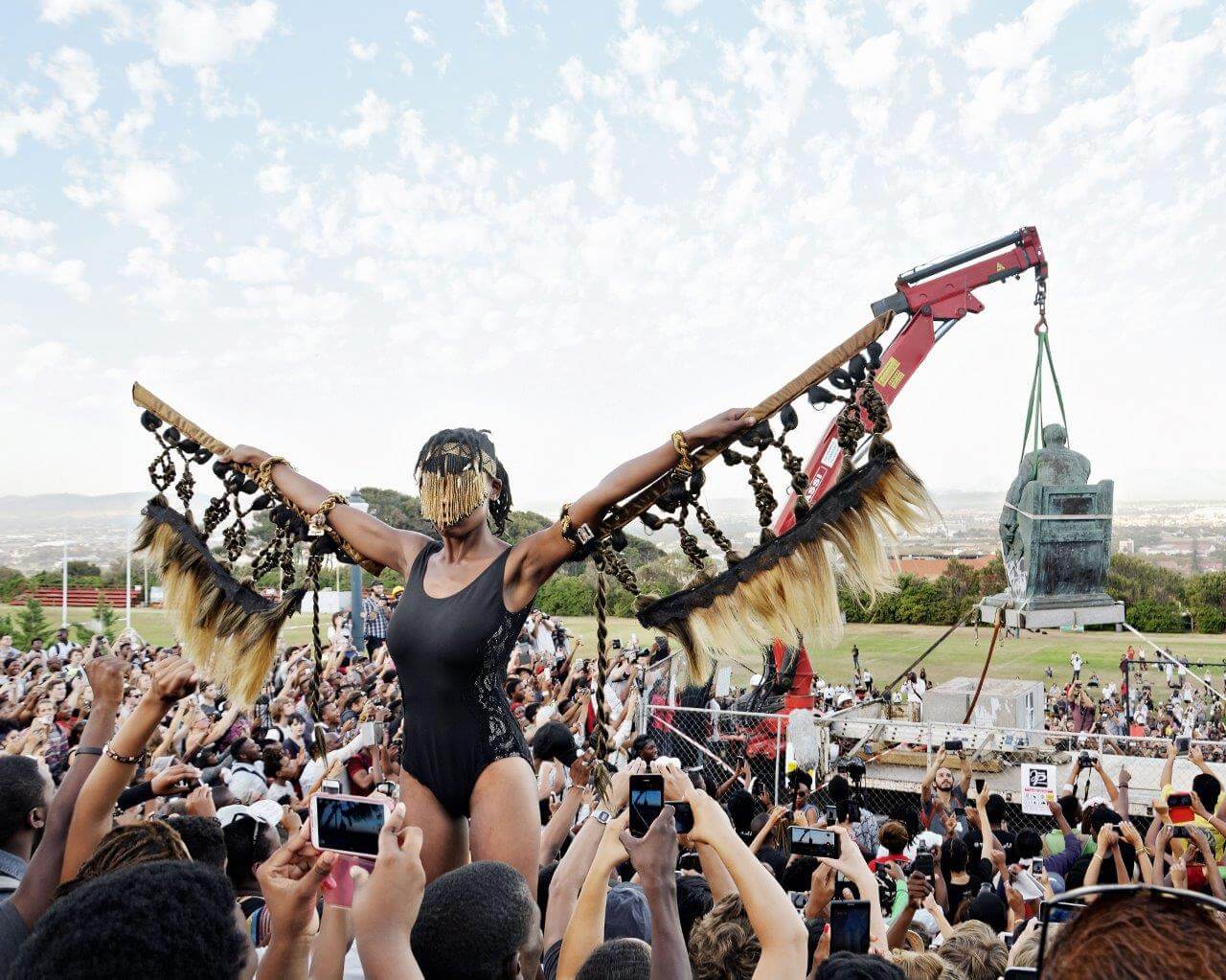The Art of Disruptions: Some Reflections
On Thursday 22nd September I attended the opening reception of the exhibition The Art of Disruptions at the Iziko South African National Gallery. To be frank and to assume a contested, reflective position in the practice of art criticism, the exhibition was neither compelling nor disappointing in its curatorial narrative and comprehension.
It rather borders on the effect of excess and the overwhelming. There are too many artworks on display; artworks most of which are already known hence their presence. And more so, the visual arrangement provided nothing novel nor challenging. In a word, nothing is disruptive about this exhibition.

Sethembile Msezane, ‘Chapungu – The Day Rhodes Fell’ (2015) Photographic print
Instead, it comes across as just another edible chorus of various artworks whose curatorial assemblage in fact betrayed its inviting title. In my effort to comprehend and work with the charged concept disruption, I sincerely laboured in trying to discover what is disruptive about the artworks on display. Perhaps my disappointment had to do with my preoccupation with our exciting juncture marked by decolonial insurgences driven by university students.
Even that being the case, I remain interested in the potential of the inextricable working and application of politics and aesthetics in art, characteristics that seem unpersuasively explored in this curated exhibition. My critical reflections are prompted by the lack of and thus a wish for, an informative and pleasurable curatorial indulgence in an exhibition that is not short of aesthetic considerations whilst equally engaging and rhyming with contemporary politics and the aspirations of our times.
Yet, it was worth seeing some seminal art pieces on display. In the exhibition, art works invited a critical consideration of sound curatorial practices and more so writings that are theoretically and historically informed and reflectively engaging. The absence of an accompanying catalogue book to such important exhibition seldom is helpful to my foregoing concern. Rather it contributes to the deficit of discursive clarity and knowledge production.

Simphiwe Ndzube ‘Raft’ 2015
Found clothes, zips, wood, hessian, umbrella , waste bins, rope,metal, wire
Nevertheless, the exhibition’s strength is partly realized through the live yet temporary art performances of Sethembile Msezane and Dean Hutton, for example. In fact, the publication of Msezane’s enthralling live art performance speaks to this invested affect of this exhibition. For her performance was the talk of what to look forward to.
Thus I was also motivated, not to mention so anticipatingly exercised. Both Msezane and Hutton did not disappoint. These artists provided moments that invite critiques and appreciation of social, cultural and political issues through subjective performances. They brought to public attention questions of history, culture, identity, race, racism, gender, sex, rituals, class, etiquettes, etc. Their performance artworks seem indicative of reflexive processes of embodiment, subjectivity and agency, which are all central in utilizing the self-body of the artist as both content and form, subject and object, material and medium, meaning and language, to explore and interrogate a variety of concerns. They achieve these possibilities through performative approaches that however remain wanting artistically or aesthetically, innovatively or imaginatively.
The defect of these art performances (like many other artworks polluting the contemporary South African art scene) lies in their over investment in subject contents. It is an investment which not only dominates creative forms to a degree of aesthetic paralysis but also undermines and cripples the importance of artistic language. It would seem, in these performances, what matters is the subject matter.
Nothing more nothing less! Creative strategies or artistic tactics with respect to craft, technique, modes of visually speaking are not attended to the same extent to which the subject contents are. Thus it is not an overstatement to say most of the current works of performance art tend to trade on the excess of subject contents or the spectacle of subject matter.
Viewers of this art are mostly overwhelmed by the what which seems to be a pressing matter of concern and exploration, but undertaking in ways that undermine or are at the great expense of how the artists in their varying manners narrate, enunciate and arrive at what constitutes their preoccupation. This is to say the meaning of and in artworks appears to matter more than the creative means through which it is constructed, produced, re-presented and displayed.
It should be noted that my foregoing reflective meditations are in no way an advocacy of pure formalism or aesthetic limpidness. I am rather concerned with the creative language or artistic procedure with which (performance) artists work in their varying ways of meaning production and knowledge contestation both of whose representation and message are always already up for differing analysis and interpretation.
What seems to drive my critical desire is for artworks that are consciously rich and profound both in content and form, themes and aesthetics. I seem longing for insightful and inspiring ways that are indicative of imaginative articulation or innovative enunciation; those artistic tactics that are novel or path opening if not originally groundbreaking. This is not too much to ask for and from Contemporary works art.
I am calling for artwork consciously vested with creative devices that have the potential of seizing the viewers’ attention and subjection to a realm in which there is a possibility for mental and emotional shifts. This is one of the powerful potency of the ways in which artworks should operate as enlightening or disruptive apparatus. It is this potency which seems absent from The Art of Disruptions exhibition.
One of the ways in which the potential art force works is through subjection. When viewers observe or participate in that rapturous realm wherein mental or emotional shifts are possible and attainable, it is not by means of overpowering subject contents alone. Creative ways of treating, talking about and re-presenting subject contents are equally important, if not a crucial prerequisite in making artworks that are profoundly compelling both in content and form.
As much I am sincerely moved by the meaning and enjoyment derived from the performance artworks of Msezane and Hutton. I am equally prompted to reflect even briefly on the deficit and problems of their artistic offerings. It is a deficit that is observable in many (performance) artworks of artists who have become darling of the art world locally and internationally.
Furthermore, works of these artists prompt another detectable problematic indulgence of narcissism in performance art, particularly the obsessive present-ness and re-presenting of the artist’s self-body. The artist’s self-body would seem to have become an excessive spectacle so much that one has to wonder if there is nothing else other than or beyond the contemporary obsession with individualism and self-introspection.
The artist’s turn to the self has unbearable implications of fetishization, a sort of voluntary pornography or sexing the self, in particular with regards to those autobiographic artworks whose centering of the artist’s personal self tends to be an excessive totem of narcissism.
I make this argument well aware of the waning down if not evaporating currency of what underpins the meaning of the personal is political, not to mention the drying up of polemic art. As the popular saying teaches us: too much of a good thing is dangerous. Of course I make these comments well aware of varying observations, readings and interpretations of contemporary (performance) artworks and curatorial inclinations, thus my foregoing arguments are just a minor provocation in a complex and contested debate on the meaning, significance, value and merit of our contemporary artists’ and curators’ work.